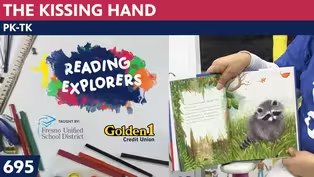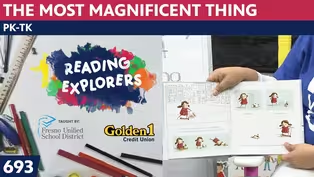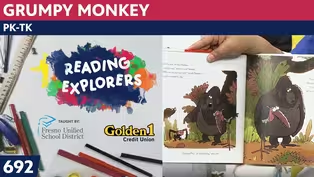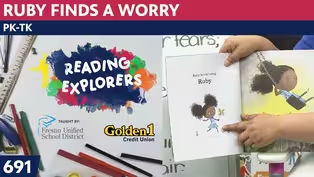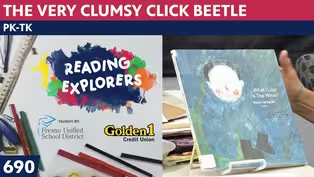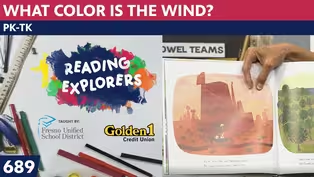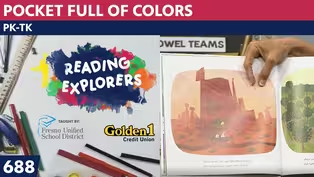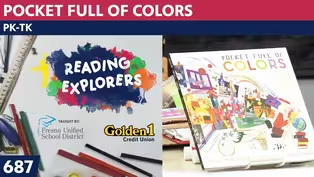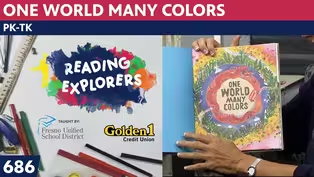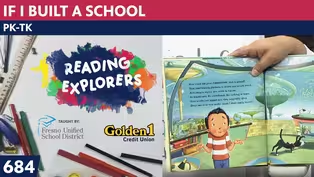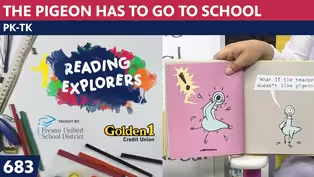
TK-372: Marc Chagall - Sun on the Village
Season 3 Episode 403 | 14m 8sVideo has Closed Captions
Today's art is "Sun on the Village" from Marc Chagall
Join me today as we continue our study of one of my favorite artists, Marc Chagall.. Each day we will enjoy a Chagall masterpiece that shows his dreamlike art. Today's art is "Sun on the Village." We will create art using the elements associated with Chagall's style...architecture, people, animals, and various objects.
Problems playing video? | Closed Captioning Feedback
Problems playing video? | Closed Captioning Feedback
Reading Explorers is a local public television program presented by Valley PBS

TK-372: Marc Chagall - Sun on the Village
Season 3 Episode 403 | 14m 8sVideo has Closed Captions
Join me today as we continue our study of one of my favorite artists, Marc Chagall.. Each day we will enjoy a Chagall masterpiece that shows his dreamlike art. Today's art is "Sun on the Village." We will create art using the elements associated with Chagall's style...architecture, people, animals, and various objects.
Problems playing video? | Closed Captioning Feedback
How to Watch Reading Explorers
Reading Explorers is available to stream on pbs.org and the free PBS App, available on iPhone, Apple TV, Android TV, Android smartphones, Amazon Fire TV, Amazon Fire Tablet, Roku, Samsung Smart TV, and Vizio.
Providing Support for PBS.org
Learn Moreabout PBS online sponsorshipMore from This Collection
Valley PBS and Fresno Unified School District have partnered with Golden 1 Credit Union to create Reading Explorers Lessons for grades Pre-Kindergarten through Third grade. The daily lessons will be taught by Fresno Unified School District teachers and are created to help students practice their reading skills and reinforce lessons during distance learning.
Video has Closed Captions
Valley PBS presents Reading Explorers Lessons for Pre-Kindergarten and TK. (26m 27s)
PK-TK-693-The Most Magnificent Thing
Video has Closed Captions
Valley PBS presents Reading Explorers Lessons for Pre-Kindergarten and TK. (26m 26s)
Video has Closed Captions
Valley PBS presents Reading Explorers Lessons for Pre-Kindergarten and TK. (26m 28s)
Video has Closed Captions
Valley PBS presents Reading Explorers Lessons for Pre-Kindergarten and TK. (26m 28s)
PK-TK-690: The Very Clumsy Click Beetle
Video has Closed Captions
Valley PBS presents Reading Explorers Lessons for Pre-Kindergarten and TK. (26m 22s)
PK-TK-689: What Color is the Wind?
Video has Closed Captions
Valley PBS presents Reading Explorers Lessons for Pre-Kindergarten and TK. (26m 21s)
PK-TK-688: Pocket Full of Colors
Video has Closed Captions
Valley PBS presents Reading Explorers Lessons for Pre-Kindergarten and TK. (25m 58s)
PK-TK-687: Dancing Through Fields of Colors
Video has Closed Captions
Valley PBS presents Reading Explorers Lessons for Pre-Kindergarten and TK. (26m 20s)
PK-TK-686: One World Many Colors
Video has Closed Captions
Valley PBS presents Reading Explorers Lessons for Pre-Kindergarten and TK. (27m 13s)
PK-TK-685: School is Wherever I am
Video has Closed Captions
Valley PBS presents Reading Explorers Lessons for Pre-Kindergarten and TK. (26m 32s)
PK-TK-684: If I Built a School
Video has Closed Captions
Valley PBS presents Reading Explorers Lessons for Pre-Kindergarten and TK. (26m 21s)
PK-TK-683: The Pigeon Has to Go to School
Video has Closed Captions
Valley PBS presents Reading Explorers Lessons for Pre-Kindergarten and TK. (26m 22s)
Providing Support for PBS.org
Learn Moreabout PBS online sponsorship♪ Good morning to a brand new day ♪ ♪ Time to learn and games to play ♪ ♪ Learning things is so much fun ♪ ♪ Learning is good for everyone ♪ (lighthearted guitar music) (bright music) - Hello, early learners.
And welcome back to the art room.
Let's greet each other with our hello song.
♪ Hello, nice to see you, everyone ♪ ♪ Hello, nice to see you, everyone ♪ ♪ Hello to you, hello to you ♪ ♪ Hello to you, hello to me ♪ ♪ Hello, nice to see you, everyone ♪ Yesterday, we started with my favorite artist, Marc Chagall.
I like his pictures because the colors are vibrant, which means bright and clear.
And he has interesting subjects in his artwork.
We brought out animals yesterday, maybe you'll see a goat, or a chicken, or a cow, or sheep, or you might see a rooster, and Chagall did that because he liked those animals and they were familiar to him from his village that he lived in, in Russia.
And he loved his village.
On Friday, we're gonna talk about how he'd made a picture of himself with two faces.
One, looking back to his village in Russia, and one looking ahead to when he went to live in Paris, in France.
So people call him a French-Russian artist because he did his art in both places.
But today, we're going to look at a picture called "Sun on the Village" and it's Marc Chagall's picture that he does that has a lot of the things we talked about included in there.
And yesterday, I didn't sing to you this song about "I in the Village," which I kept out here so that you can still see it from yesterday when we sing about it, because it says, ♪ A woman playing violin completely upside down ♪ ♪ A row of colored houses and a church inside the town ♪ ♪ Marc Chagall painted to inspire you and me ♪ ♪ To paint a green-faced man, a goat, or even a small tree ♪ And that is our Chagall song.
Let's look at Marc Chagall again.
Remember that he lived to be 98 years old [Instructor] and he was an artist that painted so many paintings.
And if you want to learn more about him, you can look online and just put M-A-R-C, Marc Chagall and you could see his artwork there.
And here is the one we're looking at today.
It's called "Sun on the Village."
So the sun is shining down on the village but something interesting I want you to notice.
There is a moon in the middle of the sun shape.
Here is the village and it's rows of tiny houses and they are rectangles with a kind of trapezoid top on their roof.
We have a farmer with his horse, pulling a wagon.
We have people hugging here.
We have two people down here.
We have a villager here, and here is the chicken.
And you'll notice that the couple is sitting on the chicken or rooster.
And up in the sky, there's a horse floating in the sky, and a man upside down floating in the sky.
So what we're going to do is called the Turn, Turn, Turn.
We're going to turn our paper and draw, we'll turn our paper and draw, turn our paper and draw, and we'll fill it in with watercolors.
So let's take a look.
Here is one someone made, a child made this one but they did one that didn't do too much turning around, except here is the Earth with trees upside down and a person upside down.
And the car is upside down.
So let's get started.
I brought this little frame cause sometimes I say, "Oh, do you mean this?
Or do you mean this?"
And if your teacher has one of them, they can use it or their golden paintbrush to point things out.
I wanted to remind people about that.
So I'm going to put all of my things down.
I had a whole container of things I can use for drawing.
I'm gonna put my table up on my lap and move my things up here and show you what I mean about Turn, Turn, Turn.
So first I'm going to do a picture that has the horizon line.
[Instructor] So you can make yours wiggly or you can make it straight.
Here's my horizon line.
And remember, the horizon line means where the Earth meets the sky.
So you drew your horizon line.
Now, I'm going to keep this here so that I can do my rectangle village houses.
Small, I do a line up, a line up, and where this one is straight, I just move up here and make it a little straight line there.
All right, the village houses are close to each other, so I'm doing the rectangle there, close it up, do my trapezoid up little diagonal line, trapezoid up little diagonal line.
I could make a row of a few of these.
And then I'm going to think about how I want to make my church and the steeple.
Diagonal line, diagonal line, partway up.
I try to make them end at the same place so they have that.
I can do my windows.
On his art, he hardly ever shows the doorways of these village houses, but you can.
You can make your houses how you would like.
You can make some kinds of shingles.
If you want your houses to be fancier, decide how you want them to look.
And then I'm going to do this one curved like a church.
With curve placed here with maybe a bell in there I might want to put, and then up at the top, I will make my cross.
Now, I'm going to turn my paper.
Over here, I'm going to make a person.
Maybe it can just be like mat man how we make his body be shapes.
And you can decide if you want yours to be a woman or a man.
And I think mine, I will have him holding something.
Maybe I'll make him have a violin, which kind of looks like the number eight, with the strings and the frets up there.
And I'll put his hand holding it.
I'll put him in a hat.
The picture that we're looking at today, you don't really see the character's faces.
They're just there.
Okay.
He'll be floating down that way.
I think I'll turn my paper again.
Over here, I think I'll make a chicken.
So I just make its peck, go down and make its tail with feathers.
Come up here, make its beak two triangles.
I'll put the comb on top of its head and the coroncal under its chin.
Okay.
So we've put in animals.
We've put in floating people, a violin, a church, a village.
I'm gonna turn this way.
And on the ground down here, I think I will make my tree.
You can decide what kind of tree you like.
A lot of times, children your age, try to make a tree that's looks like a lollipop.
And if that's what you like, do that.
I'm gonna give it a little place to go there.
Now, I think I need my sun.
And I want the sun to be in the sky to shine on the village because that is what the name of our picture is.
And on the one that we were looking at, he had triangles coming off of his.
Do you want that?
Do it.
If you don't, that's okay, too.
So I'm going to put my pieces around.
So this Turn, Turn, Turn picture is kind of fun to do 'cause you aren't expected to draw upside down that's why when I'm doing this on the tabletop and I think, "I hope the children can see."
I'm going to begin painting so that you can see what I'm going to do.
And remember, I talked to you about mixing up your paint so they don't just look like they came from the store.
You like to have a mixture so that your painting doesn't look like it just came out of the box.
So to do that, you need to have water that you can put into your lid.
And you know I'm lucky enough to have that paintbrush that has the water in it.
So I'm going to go around here.
And I don't want my sky to be too black so I can put my water color on here and then go back in with a wetter brush and I'll show you what I mean.
'Cause if you do it really super dark like this, it could be a night picture.
But if you don't want it to be night, paint your area with water and then put your paints on.
And you know I told you also why I like to do this painting on my lap is because the paints don't run.
If I'm trying to make myself do a watercolor area.
'Cause if I put too much water, the watercolor runs into the grass area, then I have to think, "Oh, maybe I could make that into a pond."
If it goes over too far into my picture and I don't like it.
So now, watch, I'm going to dip in to my water, put some water here, then add some more color to it so that it will be a darker blue, but not quite as dark as if it was straight out of the bucket.
Now, the paints that I bought have a lot of different colors in it that maybe yours doesn't have.
'Cause the ones that you usually can get, usually have just eight colors in it.
So you just have to mix it, and to mix this dark blue, you could mix your purple and the blue that's in your bucket together to make that be a color that you want.
And I can go back in and put some clouds in by using my water and stretching the color over.
Just put my paintbrush in here, got on to this.
I can add this a little bit more to this one and then finish up my sky.
And you can think about what colors you think go well together.
I made this game too.
I should put it in my Facebook page that tells about PBS Art and have your teachers be able to get it.
'Cause if you roll a number one, it says, "Draw a chicken."
If you roll a number two, it says, "Draw a person."
So it's a little game that you can just do directions that way and make this all a new project.
'Cause if you just do it one way, you think, "Well, that was fun, but I'd like to try it a different way."
And that is that little game.
You can do your paintings that way.
Let me go on to what my houses might look like.
I look in the one that's on from Marc Chagall and all of his, kind of have dark yellowish and brown houses.
'Cause I think he wanted it not to be the most important part of the painting 'cause it was really the sun that was the most important part to him, I think, 'cause it's the brightest, and the thing you really notice first.
And that's one of the principles of art is the emphasis.
You think, "Oh, what do I want to show up the most?
What is the central thing I want people to understand about this?"
Boys and girls, so you can see, I will not be able to finish this today, but I wanted you to know that tomorrow, we're going to be doing another village.
It's called "Russian village," and it needs the same materials.
If you would bring black paper this time because the Russian village is going to be a night picture.
And you'll bring black paper, your oil pastels, and I'm using my newspaper pad so that the pastels will brush in there really nicely.
Now I'm going to make my temple.
It's kind of gonna be Adobe, so I'm watering this down.
I'm gonna keep painting but I'm going to sing goodbye to everyone.
♪ Goodbye, see you next time everyone ♪ ♪ Goodbye, see you next time everyone ♪ ♪ Goodbye to you, goodbye to you ♪ ♪ Goodbye to you, goodbye to me ♪ ♪ Goodbye, see you next time everyone ♪ Boys and girls, look how I'm going to make this little part in here be a dark place 'cause it's going into the church and closing things up so that when they go into church, they'll be inside the vestibule and see what's going on in there.
All right, thank you for joining me today.
I think we had a really good time doing this Turn, Turn, Turn picture.
And we'll do something similar.
I think maybe tomorrow.
Thanks for joining me, boys and girls.
See you tomorrow.
Bye bye.
(lighthearted guitar music) ♪ Good morning to a brand new day ♪ ♪ Time to learn and games to play ♪ ♪ Learning things is so much fun ♪ ♪ Learning is good for everyone ♪ (lighthearted guitar music continues)
Support for PBS provided by:
Reading Explorers is a local public television program presented by Valley PBS
